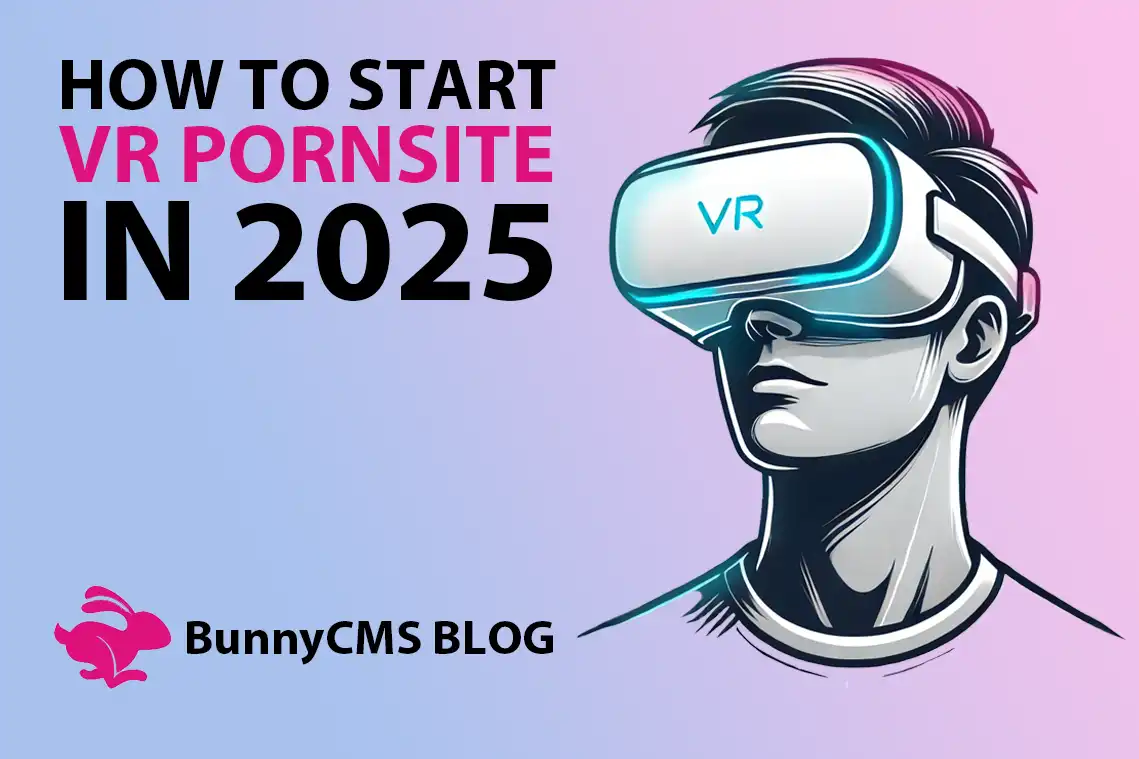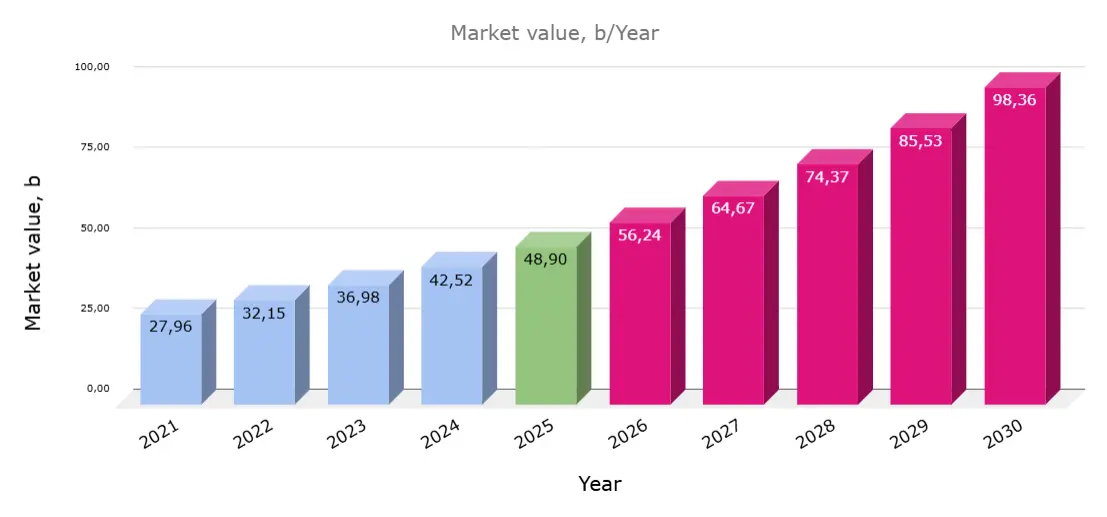How to Create a Website with VR Videos in 2025
06 January 2025Virtual Reality (VR) is a technology that transports a person into a fully created digital world. Using specialized headsets like Oculus or HTC Vive, users can feel immersed in this world thanks to a full immersion effect.

Introduction: What is VR and Why is it Popular?
The main reason for VR's popularity is its ability to create an immersive experience. In other words, a person doesn’t just watch a screen; they feel like a participant in the events. This technology has become a hit in many areas: from gaming, where you can feel like a superhero or racer, to adult entertainment content, where VR opens new horizons for intimate experiences.
The Role of VR Porn in the Market
Today, VR porn accounts for about 3.4% of the total $45 billion pornography market. However, its share is rapidly growing, with projections estimating it will constitute over 50% of industry revenues by 2030. Additionally, VR porn holds an 11% share of the AR/VR technology market, and this figure also has significant growth potential.

The annual market growth rate for VR is approximately 15%.
Chapter 1: How to Create Your Website with VR Videos
Building websites for VR videos is a complex and multi-stage process. This is especially true for adult content, where extra attention to legal and technical aspects is required. However, maintaining such websites is even more challenging, as it requires constant content updates, platform stability, and meeting users' growing expectations.

Bunny CMS offers tools that significantly simplify these tasks. With a user-friendly interface, built-in video functionality, and VR support, this platform allows even small teams to create competitive projects. With Bunny CMS, you can launch your VR website in no time, forget about the technical side, optimization, and other challenges, and focus solely on creating new and exciting content.
Request a Free ConsultationCurrently, there are very few ready-made solutions for launching such video content. Besides Bunny CMS, most platforms lack the necessary functionality, meaning you’ll need to do almost everything yourself. This includes building a specialized backend, optimizing for streaming heavy video content, and integrating modern VR technologies.
Launching a VR video website requires modern web technologies and frameworks. The basis for working with VR content is support for WebXR or WebVR, which enable the playback of 3D content in a browser. Code for such sites is typically written in JavaScript, using libraries like Three.js or A-Frame, designed for virtual reality.
For the server side, you should use programming languages that suit your current technologies, such as PHP if your site already runs on it. The server must ensure fast data processing, streaming, and support for HLS for optimal video streaming.
Chapter 2: Optimizing VR Videos for All Browsers and Devices
Optimizing VR videos is a key aspect of ensuring the site works successfully. It guarantees compatibility with a variety of devices and browsers, providing a comfortable experience for all users.
Universal Solutions
One of the main tasks is to create a universal solution that works on VR devices, regular browsers, or phones. We cannot limit users by forcing them to purchase additional devices or install applications. The videos must be accessible to everyone: on VR headsets, computer browsers, mobile browsers on iOS and Android (both in landscape and portrait orientations), and tablets. Moreover, full-screen mode on mobile devices with phone position sensors must be supported.
Optimizing for VR Playback Devices:
| Device | Users (%) |
|---|---|
| Oculus Quest | 12% |
| Oculus Quest 2 | 15% |
| Oculus Rift | 8% |
| HTC Vive | 10% |
| HTC Vive Pro | 5% |
| Valve Index | 7% |
| PlayStation VR | 20% |
| Meta Quest Pro | 6% |
| Pico Neo 3 | 3% |
| Samsung Gear VR | 4% |
| Google Daydream | 2% |
| Windows Mixed Reality | 8% |
Smartphone Users:
Headsets with lenses: Merge VR Goggles is a popular option for viewing VR content on smartphones, offering a high-quality experience with a user-friendly design and compatibility with most modern smartphones.
- Android smartphones with VR support (25% of users)
- iOS devices with VR support (10% of users)
Browser Optimization
Different browsers have unique VR content playback characteristics that should be considered during site optimization:
- Google Chrome:
- Best WebXR API support.
- High performance on Windows, macOS, and Android.
- Recommended for testing integration with Oculus and HTC Vive headsets.
- Mozilla Firefox:
- Excellent compatibility with WebVR API, though WebXR support is developing more slowly.
- Recommended for users with more technical needs and Linux-based systems.
- Microsoft Edge:
- Based on Chromium, so it shares similar characteristics with Chrome.
- Optimized for Windows Mixed Reality headsets.
- Safari:
- Limited WebXR support, with a primary focus on ARKit for iOS.
- Video optimization should account for the specifics of iPhone and iPad devices.
- Opera:
- Less popular but supports Chromium API, making it compatible with VR content.
Main Optimization Principles:
- Utilizing WebXR and WebVR: Ensure the integration of these APIs for proper VR content playback.
- Reducing file sizes: Optimize video files using high-compression formats (e.g., H.265) without losing quality.
- Testing on all devices: Verify video functionality across all major headsets and mobile devices.
- Ensuring stable streaming: Use HLS alongside CDN solutions to minimize playback delays.
- Scalability: Automatically adjust video quality based on the user's device and internet connection speed.
Keeping the Site Updated
Given the rapid development of VR technologies, your site must be ready for changes and updates. Regular checks for compatibility with new devices, browsers, and VR standards are essential to ensure quality service.
Chapter 3: Why You Should Create Such Websites
- Paying Audience: The primary audience for VR porn consists of individuals aged 25–34, who are actively interested in new technologies. This age group is characterized by high purchasing power, meaning a well-organized site can generate significant revenue.
- High User Engagement: Research shows that nearly all VR headset owners have tried viewing VR porn at least once. This indicates that your potential audience is already prepared to explore such content if you can offer them the best experience.
- Low Competition: Currently, there are few VR porn sites, and those that exist typically offer limited content. This is the perfect time to enter the niche.
- Growing Demand: The demand for adult VR content continues to grow rapidly. By 2030, the VR porn market is projected to reach $124.5 billion, making it one of the most promising sectors in the VR industry.
Chapter 4: SEO Support for VR Content Websites
Optimizing your site for search engines is a key aspect of attracting an audience, especially for specific content like VR videos. This not only improves your site’s visibility in search engines but also ensures a high-quality user experience.
- The Niche is Challenging: For VR content, a different approach to marketing is required, including creative and engaging advertising. It’s essential to find methods that not only attract new users but also convince them to stay on your platform.
- SEO is Also Different: It’s crucial to focus on clearly defined directions to ensure that investments in SEO optimization yield results. For example, prioritize the most popular keywords, create a proper site structure, and adopt a specific approach to adult content.
For additional insights, check out our blog articles on SEO for the adult industry:
- Top 5 Porn Niches for SEO in 2025: Helps you identify the most popular niches and understand their specifics.
- SEO Strategies for Adult Websites: Learn optimization tips for adult content sites to attract more target audiences.
Conclusion
Creating a VR video website in 2025 is a promising yet challenging endeavor. The VR industry is rapidly evolving, offering many opportunities for innovation and audience engagement. However, success depends on the right choice of technologies, effective optimization, and high-quality content.
It’s important to ensure a universal solution accessible across various devices and to keep the site updated consistently. Special attention should be given to marketing and SEO, adapting approaches to the specifics of the VR content niche.
If you can meet the modern user's needs by providing a high-quality VR experience, your site will become a competitive and profitable project in the long run.
Related Articles
- Key Mistakes to Avoid for a Successful Adult Website
- How to Start a Porn Business: First Steps and Key Challenges
- The Best Adult Business Podcasts You Should Listen To